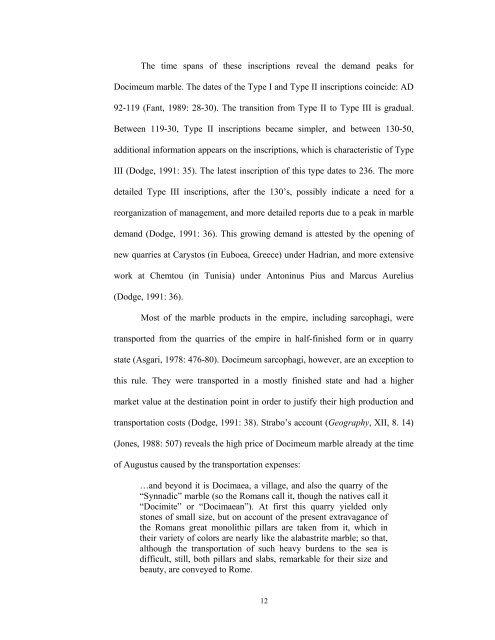To My Family and Uğraş Uzun - Bilkent University
To My Family and Uğraş Uzun - Bilkent University
To My Family and Uğraş Uzun - Bilkent University
You also want an ePaper? Increase the reach of your titles
YUMPU automatically turns print PDFs into web optimized ePapers that Google loves.
The time spans of these inscriptions reveal the dem<strong>and</strong> peaks for<br />
Docimeum marble. The dates of the Type I <strong>and</strong> Type II inscriptions coincide: AD<br />
92-119 (Fant, 1989: 28-30). The transition from Type II to Type III is gradual.<br />
Between 119-30, Type II inscriptions became simpler, <strong>and</strong> between 130-50,<br />
additional information appears on the inscriptions, which is characteristic of Type<br />
III (Dodge, 1991: 35). The latest inscription of this type dates to 236. The more<br />
detailed Type III inscriptions, after the 130’s, possibly indicate a need for a<br />
reorganization of management, <strong>and</strong> more detailed reports due to a peak in marble<br />
dem<strong>and</strong> (Dodge, 1991: 36). This growing dem<strong>and</strong> is attested by the opening of<br />
new quarries at Carystos (in Euboea, Greece) under Hadrian, <strong>and</strong> more extensive<br />
work at Chemtou (in Tunisia) under Antoninus Pius <strong>and</strong> Marcus Aurelius<br />
(Dodge, 1991: 36).<br />
Most of the marble products in the empire, including sarcophagi, were<br />
transported from the quarries of the empire in half-finished form or in quarry<br />
state (Asgari, 1978: 476-80). Docimeum sarcophagi, however, are an exception to<br />
this rule. They were transported in a mostly finished state <strong>and</strong> had a higher<br />
market value at the destination point in order to justify their high production <strong>and</strong><br />
transportation costs (Dodge, 1991: 38). Strabo’s account (Geography, XII, 8. 14)<br />
(Jones, 1988: 507) reveals the high price of Docimeum marble already at the time<br />
of Augustus caused by the transportation expenses:<br />
…<strong>and</strong> beyond it is Docimaea, a village, <strong>and</strong> also the quarry of the<br />
“Synnadic” marble (so the Romans call it, though the natives call it<br />
“Docimite” or “Docimaean”). At first this quarry yielded only<br />
stones of small size, but on account of the present extravagance of<br />
the Romans great monolithic pillars are taken from it, which in<br />
their variety of colors are nearly like the alabastrite marble; so that,<br />
although the transportation of such heavy burdens to the sea is<br />
difficult, still, both pillars <strong>and</strong> slabs, remarkable for their size <strong>and</strong><br />
beauty, are conveyed to Rome.<br />
12
















